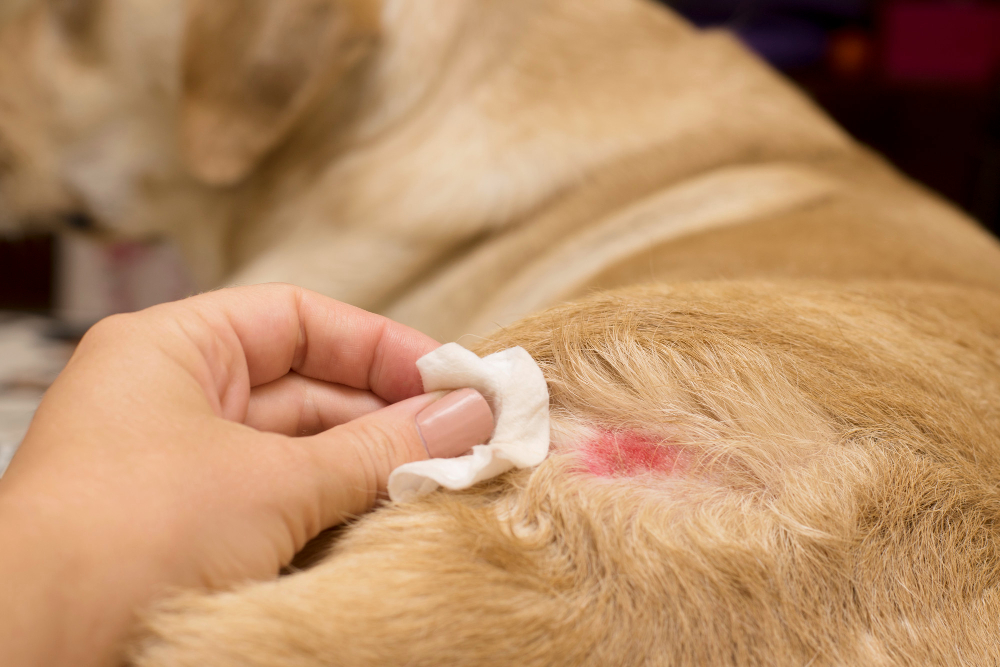In the adventurous life of a dog, occasional wounds, cuts, or scratches are inevitable. As dog owners, it’s crucial for us to understand the types of dog wounds and how to respond effectively. Here, we’re going to answer your questions: “What can I apply on my dog’s wound?” “How do I treat my dog’s wounds at home?” “Can you use human wound cream on dogs?” and “What helps dog wounds heal faster?”
Understanding Dog Wounds: Types and Causes
In the realm of pet care, being able to identify the types of dog wounds is fundamental. Whether it’s cuts, scrapes, puncture wounds, bite wounds, or lacerations, these common injuries can stem from a variety of sources — a rowdy playtime, an unexpected encounter with a thorny bush, or a run-in with another animal. While we, as pet owners, can learn to recognize different wounds, it is crucial to remember that the appropriate treatment for each wound type should ideally be determined by a professional veterinarian.
Can You Use Human Wound Cream on Dogs?
An often-asked question is: Can you use human wound cream on dogs? While some human creams are safe, many are not. Dogs have a different skin composition, and certain ingredients, even those benign to us, can be toxic to them. Always opt for dog-specific products to ensure safety. For example, some pet owners wonder, can my dog use Neosporin?
Treating Dog Wounds at Home: A Step-by-step Guide
Effectively learning how to heal a dog wound fast at home involves a few crucial steps:
- Clean the wound: Using saline solution and mild soap, clean around the wound. Avoid getting soap in the wound as it may cause irritation.
- Disinfect: Apply a pet-friendly disinfectant to clean the wound. This is a crucial step in preventing infections.
- Apply an ointment: Use an appropriate cream or ointment made for dogs to promote healing.
- Bandage if necessary: If the wound is in an area where the dog can lick or scratch, it might be a good idea to bandage it. Make sure not to wrap it too tightly.
- Use a silver spray: After the wound has been cleaned and treated, apply a silver spray to ward off flies. This is an essential preventive step against flystrike, a condition also known as myiasis, where flies lay eggs in the wound that later develop into maggots.
- Utilize an Elizabethan collar: To ensure your dog doesn’t interfere with the wound and its healing process, consider using an Elizabethan collar, commonly known as the “cone of shame”. This prevents your pet from licking or biting the affected area, allowing the wound to heal faster.
Remember, while treating dog wounds at home can be effective for minor injuries, serious wounds or any signs of infection should always be addressed by a professional veterinarian.
Best Ointments for Dog Wounds
Identifying the best ointment for dog wounds is key to effective home treatment. There are many options in the market, each having specific benefits. Some popular choices include Vetericyn, Zymox, and Curaseb. These are formulated specifically for dogs and can help speed up the healing process.
Natural Antiseptics for Dog Wounds
For those inclined towards holistic solutions, treating dog wounds naturally can be a preferred choice. Many natural antiseptics for dog wounds exist that can be used effectively and safely. Honey, with its natural antibacterial properties, can be used on clean wounds. Certain essential oils such as lavender and chamomile, known for their healing properties, are also safe for dogs when used correctly. However, they should always be diluted before use, and care should be taken to avoid contact with the dog’s eyes, nose, or mouth.
Despite the benefits of these natural options, it is important to note that natural treatment does not replace conventional treatment. Always consult with a veterinarian when deciding on a treatment plan for your pet’s wounds. Natural remedies can be a part of this plan, but should not be relied on as the sole method of treatment, especially in the case of serious or infected wounds.
Speeding Up the Healing Process: How to Help Your Dog’s Wounds Heal Faster
To help your dog’s wounds heal faster, ensure your pet gets proper nutrition, and prevent them from licking or scratching the wound. Maintaining cleanliness in the wound area is also crucial. Remember, the less your pet interferes with the wound, the faster it will heal.
When to Seek Professional Help
While treating dog wounds at home is often possible, it’s important to know when to seek professional help. If the wound is deep, excessively bleeding, or showing signs of infection like pus or foul odor, it’s time to visit the vet. Remember, your dog’s health and wellbeing should always be the top priority.
Conclusion
In conclusion, dog wounds, while common, can often be managed effectively at home with the right knowledge and resources. Understanding the types of dog wounds and knowing how to heal a dog wound fast at home are critical skills for dog owners. Choosing the best ointment for dog wounds can make a big difference in the recovery process.
In many instances, opting for treating dog wounds naturally using natural antiseptics for dog wounds, alongside conventional treatment, can be a safe and effective choice. This combined approach can help speed up the healing process.
But it’s also crucial to acknowledge when a wound needs professional attention. If the wound is deep, severely bleeding, or showing signs of infection like pus or foul odor, it’s time for a veterinary consultation. Your dog’s health and wellbeing must always come first.
So, stay informed, vigilant, and proactive in caring for your canine companion. When in doubt, consult with a professional. Their expertise will provide guidance and peace of mind, ensuring that you’re offering the best possible care for your pet.

